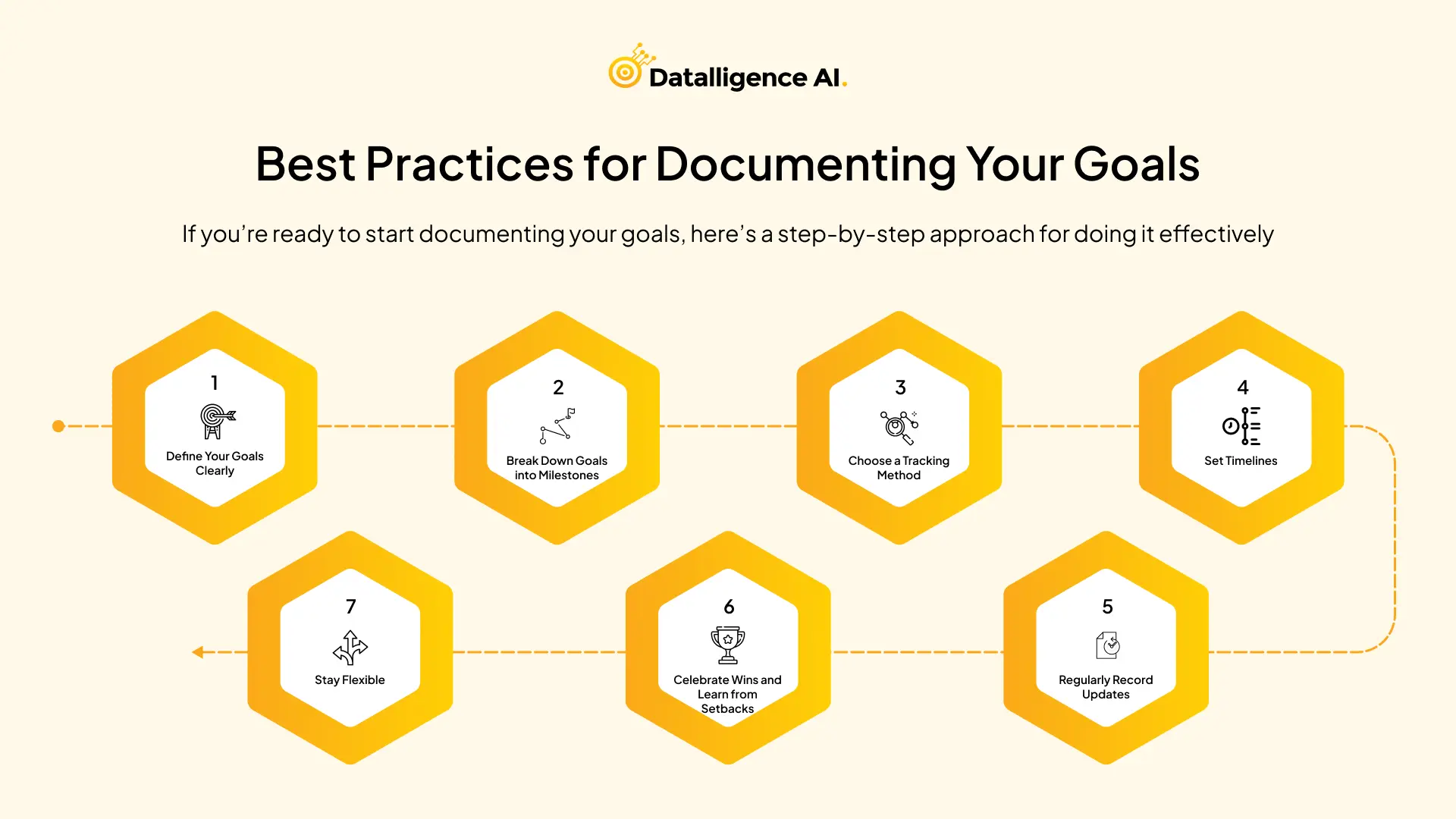According to a 2024 study by McKinsey, organizations that actively track and document their goals are 42% more likely to achieve them compared to those that don’t. As we move into 2025, tracking and documenting goal progress has become more crucial than ever for both individuals and organizations. In today’s fast-paced, results-driven environment, simply setting goals is no longer enough. To achieve success, you need a clear system, such as OKR software, for monitoring progress, adjusting strategies, and celebrating wins along the way.
This blog dives deep into the benefits of goal tracking, offers practical tips on documenting progress, and provides real-world examples of how OKRs can drive success in 2025. Whether you’re leading a team, managing personal goals, or helping others reach theirs, this guide is your roadmap to staying on course.
Feeling Lost in the Hustle of Chasing Your Goals?
Let’s Document Our Way to Success!
Goal setting can sometimes feel overwhelming, especially when you’re constantly juggling multiple priorities. The good news is that documenting your goal progress can be your secret weapon for success. Whether you’re aiming for personal growth or organizational milestones, proper documentation through goal tracking software provides clarity, accountability, and a clear path forward.
In this post, we’ll explore the importance of documenting your goals, how often to track progress, and some practical tips for collecting evidence of your achievements along the way. Let’s make 2025 the year of clear direction and tangible results!
Why Documenting Goal Progress is Crucial
Have you ever felt like your goals are floating aimlessly in your mind? Writing them down brings them to life, making them tangible and actionable. Documenting your goals is the first step in giving your ambitions structure and substance. Here’s why it’s so important:
- Increased Accountability: Documenting goals creates a sense of commitment, both to yourself and to your team. It’s like creating a contract that holds you accountable. Once it’s documented, you’re more likely to take action.
- Clear Alignment: When individual goals are documented and tracked, it’s easier to align them with larger organizational objectives. This ensures everyone is working towards a common goal, fostering a unified team effort.
- Improved Focus: A well-documented goal serves as a constant reminder of what you’re striving to achieve. It helps prioritize tasks, filter distractions, and direct energy toward activities with the most significant impact.
The Benefits of Clarity in Achieving Objectives
When goals are documented, you’re providing a clear map of where you want to go and how you’ll get there. This clarity is essential for both individuals and teams. According to Robert Kaskel, Chief People Officer at Checkr, documenting goals enables a more objective assessment of progress, showing clearly what’s working and what needs adjustment.
Additionally, written goals serve as a reference for evaluating success. Are you hitting your targets? Are there gaps to address? Documenting with a software helps you answer these questions based on data, not guesswork.
Creating Accountability Through Goal Documentation
As Gates Little, CEO of The Southern Bank Company, puts it, a goal that isn’t documented is merely an idea. Writing down your goals turns that idea into something tangible, something you can be held accountable for. Using OKR software ensures that you not only document your goals but also track progress in real time. This process allows for peer support, feedback, and continuous improvement.
Goal documentation helps leaders foster a culture of accountability within their organizations. When employees know what they need to achieve and how their progress is tracked, their focus and dedication naturally increase. The transparency provided makes it easy to monitor both personal and team goals effectively.
Aligning Employee and Organizational Objectives
Documenting goals doesn’t just benefit individuals – it aligns everyone’s efforts with the organization’s larger vision. This alignment is critical for success because, when all employees are working towards the same objectives, the overall impact is greater.
For instance, if an organization’s main objective is to improve customer satisfaction, specific team goals could include reducing response time or increasing first-contact resolution rates. Using methods and track these specific goals ensures that teams move in unison, working towards broader organizational success.
How Often Should You Document Goal Progress?
Consistency is key when tracking and documenting your goals. The frequency of updates depends on the nature of your goals, but here’s a general guide:
- Weekly: Best for short-term goals or tasks requiring close attention. This could include checking KPIs, reviewing milestones, or reflecting on weekly challenges.
- Monthly: Suitable for medium- to long-term goals. A monthly check-in offers broader reflection on progress and allows for necessary adjustments.
- Quarterly: Useful for long-term strategic objectives. A quarterly review helps assess goal alignment with overall business outcomes and identify where efforts should be focused for the next quarter.
Setting a regular cadence for goal documentation ensures timely course correction, helping you maintain focus and motivation. A software can streamline this process by automatically reminding you when it’s time for updates and offering visual insights into your progress.
How to Collect Evidence of Progress Toward Your Goals
Documenting progress isn’t just about writing down what you’ve achieved – it’s about gathering evidence that proves you’re on track. Here’s how to do it effectively:
- Set Clear Metrics: Whether your goal is to increase sales by 20% or improve customer satisfaction scores by 10 points, having measurable outcomes is key. Metrics help you track progress quantitatively and provide clear evidence of success.
- Use Tools: A dedicated OKR tool is invaluable for recording data and milestones in real-time. These tools allow you to visualize your progress and make data-driven decisions.
- Keep a Log: Recording small achievements regularly, whether daily or weekly, builds a comprehensive view of your progress. Journaling can also help reflect on your journey and any adjustments you’ve made.
- Schedule Regular Check-ins: Holding regular meetings with your team or accountability partners allows for discussion of progress and challenges. These check-ins help sustain motivation and offer a reality check on what’s working and what’s not.
Remember, setbacks are part of the process. Documenting what didn’t go as planned is crucial for learning and making improvements moving forward.
Best Practices for Documenting Your Goals
If you’re ready to start documenting your goals, here’s a step-by-step approach for doing it effectively:

- Define Your Goals Clearly
Make sure your goals follow the SMART framework: Specific, Measurable, Achievable, Relevant, and Time-bound. This ensures clarity and gives you a clear path to measure success. - Break Down Goals into Milestones
Large goals can be overwhelming. Breaking them into smaller, more manageable tasks or milestones keeps you motivated and allows for steady progress. - Choose a Tracking Method
Whether you use spreadsheets, OKR software, or a simple journal, pick a method that works best for you and stick to it. It often offers the advantage of automation, which makes tracking easier and more efficient. - Set Timelines
Assign deadlines to your milestones and goals. This keeps you accountable and helps you pace your efforts appropriately. - Regularly Record Updates
Make it a habit to consistently review and document your progress, whether weekly or monthly. This will help you stay on track and make adjustments as needed. - Celebrate Wins and Learn from Setbacks
Celebrate victories, no matter how small, as they help maintain motivation. Similarly, documenting setbacks provides opportunities for reflection and improvement. - Stay Flexible
As circumstances change, your goals may evolve. Be willing to adjust your strategies and timelines as needed and make sure these changes are reflected in your documentation.
Real-World Examples of Goal Documentation
- SMART Goals in Action:
One company aimed to enhance its mobile app’s user experience. Their SMART goal was: “Launch a mobile app update by the end of Q2, achieving 50,000 installs in six months with a 5% conversion rate.” This goal was specific, measurable, achievable, relevant, and time-bound, giving the team a clear target to work toward. - OKRs for Ambitious Goals:
OKRs are often used to track more ambitious goals. For example, a company’s sustainability initiative might have the objective: “Design products for circularity by 2025,” with key results like “Include 100% recycled materials in all new products by 2023.” This ties ambitious goals to measurable outcomes, pushing the company forward.
How to Overcome Challenges?
- Time Management: Struggling to find time for documenting progress? Schedule dedicated time for this task, using reminders from a software.
- Consistency: If consistency is an issue, set smaller milestones and update your progress regularly to keep the momentum going.
- Incomplete Data: Missing data can hinder progress tracking. Ensure you’re collecting accurate metrics by refining your KPIs and investing in the right tools.
Conclusion
Make 2025 the Year of Documenting Success!
In conclusion, documenting your goal progress goes beyond simple tracking – it drives focus, accountability, and results. Whether you’re using SMART goals for precision or OKRs for ambitious targets, documenting your journey ensures that you stay on course.
Improve goal tracking in 2025. Let’s make year of clear direction and measurable success. Keep documenting, keep progressing, and achieve those goals!











